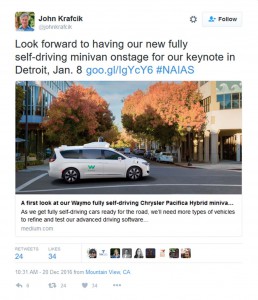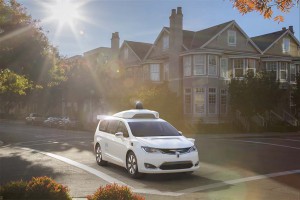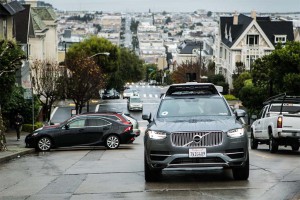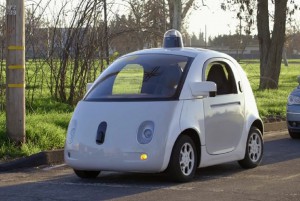Waymo, the newly renamed Google autonomous vehicle division, will pull the wraps off its latest self-driving vehicle prototype, a Chrysler Pacifica Hybrid minivan, during the opening day of the 2017 North American International Auto Show.
Fiat Chrysler Automobiles on Monday confirmed it had delivered 100 of its Chrysler Pacifica plug-in hybrid minivans to Waymo, which will now have them modified to run autonomously. When they go into operation early next year they will more than double the size of the Google spinoff’s test fleet.
“As we get fully self-driving cars ready for the road, we’ll need more types of vehicles to refine and test our advanced driving software,” Waymo CEO John Krafcik said in a tweet.
(Click Here for more on the new Waymo/Chrysler Pacifica Hybrids.)
The planned unveiling, signaled in Krafcik’s tweet, comes as something of an irony, as FCA itself has no plans to reveal anything of its own at the annual Detroit show. Instead, it is widely expected to show a fully electric version of the Chrysler Pacifica at the Consumer Electronics Show in Last Vegas the week before the annual NAIAS.
 It is possible that such a battery-electric minivan might be used as part of a future collaboration between Waymo and FCA.
It is possible that such a battery-electric minivan might be used as part of a future collaboration between Waymo and FCA.
The initial venture marks the first time the Google venture has actively partnered with an automaker on the development of autonomous technology. It previously had acquired a small fleet of Lexus vehicles and commissioned the development of some bubble-shaped “Google Cars” from Detroit supplier Rousch.
In turn, the move marked a significant step for Fiat Chrysler which has been slow to follow key rivals in the development of self-driving vehicle technology.
“Our partnership with Waymo enables FCA to directly address the opportunities and challenges the automotive industry faces as we quickly approach a future where fully self-driving vehicles are very much a part of our daily lives,” Fiat Chrysler CEO Sergio Marchionne said in a statement marking the delivery of the 100 Chrysler Pacifica Hybrids.
Both companies have made it clear that they do not see their relationship as monogamous. FCA is talking to other possible suppliers of autonomous vehicle technologies and Waymo has been in private talks with other possible customers. It had been widely expected early this year that the unit – now a standalone subsidiary of Google parent Alphabet Inc. – would also do a deal with Ford, but nothing ever materialized.
The addition of the Chrysler Pacifica Hybrids will let Waymo significantly expand its test program which is currently focused on warm weather environments like Silicon Valley, Austin, Texas and the Phoenix region. The company has said it wants to explore more extreme weather and road conditions.
Waymo recently set up a new research center in the Detroit suburb of Novi which helped in the development of the Pacificas. At least some of them are expected to soon go into operation in Michigan. Winter poses a serious challenge for autonomous vehicle sensors which rely on laser, radar and vision as well as high-definition navigation systems.
It can be difficult to find lane markers, for example, and such sensors typically have a hard time distinguishing between snow, ice or sand, each requiring different responses when accelerating, braking and turning.
Nonetheless, many believe that autonomous technology is, in Krafcik’s words, “close to an inflection point,” which would translate into being ready to put into practical use, rather than just in pilot projects.
“We’re close to bringing this to a lot of people,” Krafcik said during an event in San Francisco last week, during which the Waymo name was announced. “We’re kind of at an inflection point.”
(Google’s autonomous unit becomes Waymo, plans ride-sharing test. Click Here for more.)
Waymo isn’t the only company betting on making the rapid transition from concept to production. Tesla Motors recently announced that all future products will be equipped with an array of sensors, software and computer systems capable of taking the semi-autonomous Autopilot system to the next, fully hands-free level. The California EV maker says it will wirelessly update its onboard software as it becomes more confident in the system’s capabilities.
Nissan has said it plans to have its first fully autonomous vehicles in production by 2020 and Ford recently announced plans to go a step further, launching totally driverless vehicles by 2021. Initially, the Detroit maker said, they will be used in ride-sharing and commercial fleets, but retail versions will follow later in the decade.
Government regulators this year introduced the first federal guidelines for autonomous vehicles, and a number of states have passed their own regulations, including Michigan and California. The Golden State is now in a legal battle with Uber, the ride-sharing giant that plans to eventually replace its drivers with fully driverless vehicles.
It launched a pilot program in San Francisco last week but declined to get the requisite permit from the California Department of Motor Vehicles – which has now issued a cease-and-desist order.
Uber’s test project reveals some of the challenges it and other proponents of autonomous technology still face. Since the 11 modified Volvo XC90s went into operation last week, they have been reported running red lights, failing to yield to pedestrians and illegally crossing bicycle lanes. The company has said it has a “problem” it is trying to fix.
Waymo, meanwhile, has been involved in nearly 20 accidents so far, though only one has been blamed on its autonomous prototypes. Nonetheless, Krafcik and other officials have said they still need to do a lot of work to get past that inflection point, and the 100 Pacifica Hybrids will play a critical role.
(GM launching test of autonomous Chevy Bolt EVs. Click Here for the story.)



